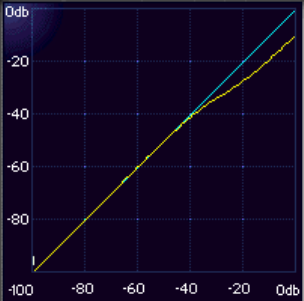
Waves LinMB software guide page 15 of 28
Chapter 5 – Range and Threshold Concept
The concept of ‘Threshold’ and ‘Range’ instead of the traditional ‘Ratio’
control creates some very flexible and powerful uses for the LINMB. They
include low-level compression and expansion, giving you multiband “upward
compressors” and noise reducers.
O
LD SCHOOL
/
ANOTHER SCHOOL
In the classic compressor approach, if you set a very low Threshold with any
given Ratio, extreme amounts of gain reduction of high level signals may
occur. For example, with a Ratio of 3:1 and Threshold of –60dB will result in a
–40dB gain reduction for 0dBFS signals. Such a case is rarely desirable, and
in general you would only set such a low Threshold in a typical compressor
when the input level is also very low. In common practice, more than -18dB of
gain reduction or +12dB gain increase is rarely needed, especially in a
multiband compressor.
In the LINMB, the concept of ‘Range’ and ‘Threshold’ comes in very handy. It
lets you first define the maximum amount of dynamic gain change using the
‘Range’ control, and then determine the level around which you want this gain
change to take place using the ‘Threshold’. The actual values of these
controls depend on the type of processing that you want.
If Range is negative; you’ll have downward gain change.
If Range is positive; you’ll have upward gain change.
The real flexible fun happens when you offset this dynamic Range with a fixed
Gain value.
H
IGH
-
LEVEL COMPRESSION
High-level compression in C1. Ratio is 1.5:1, Threshold is -35. Equivalent
LINMB setting would have Range set to about -9dB, with Gain set to 0.
If you are interested in conventional compression (termed here ‘high-level
compression’ because the dynamics of the compression happens at high
levels), simply set the Threshold to high values, between –24dB and 0dB, and
the Range to a moderate negative value, between –3 and –9. In this way the
gain changes will take place at the upper part of input dynamics — just like a
normal compressor will do.


















